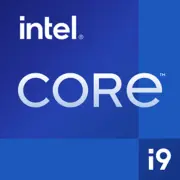Intel Core i9-13900F

Intel Core i9-13900F: Raptor Lake Power for Professionals and Enthusiasts
(Relevant as of March 2025)
Key Characteristics: Architecture and Innovations
The Intel Core i9-13900F processor, released in 2023, remains a relevant solution for demanding users thanks to its hybrid Raptor Lake architecture.
Architecture and Process Technology
- Process Technology: Intel 7 (10nm Enhanced SuperFin).
- Cores and Threads: 24 cores (8 Performance-cores + 16 Efficient-cores) and 32 threads.
- Cache: 36 MB L3 + 32 MB L2.
- Base/Boost Frequency: P-cores — 2.0–5.6 GHz, E-cores — 1.5–4.2 GHz.
- TDP: 65 W (real consumption under load can exceed 200+ W).
Key Features:
- Intel Thread Director — optimizes task distribution between P- and E-cores.
- PCIe 5.0 Support — 16 lanes for GPUs + 4 lanes for NVMe.
- Thermal Velocity Boost — automatic overclocking with effective cooling.
Performance:
- Geekbench 6: 2698 (Single-Core) / 17010 (Multi-Core).
- In Cinebench R23 tests, the processor scores ~2100 points in Single-Core and ~36000 in Multi-Core.
Compatible Motherboards: Choosing the Optimal Foundation
Socket and Chipsets
The processor uses the LGA 1700 socket, compatible with the 600 and 700 series chipsets:
- Z790: For overclocking and maximum performance (examples: ASUS ROG Maximus Z790 Hero — $450–500).
- B760: A balance of price and functionality (MSI B760 Tomahawk — $180–200).
- H770: For basic tasks without overclocking (Gigabyte H770 Aorus Elite — $150–170).
Choosing Tips:
- Ensure the board supports DDR5-5600+ or DDR4-3200 (depending on the model).
- Check the number of M.2 slots (at least 2–3 for NVMe PCIe 4.0/5.0).
- For CPU power, a solid VRM is critical — choose boards with 12+ phases (e.g., ASUS TUF Gaming Z790-Plus).
Supported Memory: DDR4 vs DDR5
The i9-13900F works with DDR5-5600 (officially) and DDR4-3200.
Standard Comparison:
- DDR5: Higher bandwidth (up to 90 GB/s) but more expensive (32 GB DDR5-6000 — $130–150).
- DDR4: Cheaper (32 GB DDR4-3600 — $70–90), but limited by frequencies.
Recommendations:
- For gaming and video editing: DDR5-6000 with low timings (CL36).
- For budget builds: DDR4-3600 + B760 motherboard.
Power Supply: Power Calculation
The official TDP of 65 W is just a base figure. Under peak load, the processor can consume up to 250 W.
Recommendations:
- Minimum: 750 W (for systems with a GPU like the RTX 4070).
- Optimal: 850–1000 W (for RTX 4090 or future upgrades).
- Certifications: 80 Plus Gold or higher (examples: Corsair RM850x — $140, Be Quiet! Straight Power 11 1000W — $200).
Important: Use an 8+8 pin cable for stable CPU power.
Pros and Cons of i9-13900F
Advantages:
1. Leader in Multi-threaded Performance: Handles rendering, streaming, and gaming simultaneously.
2. Energy Efficiency at Idle: Intel 7 technology reduces power consumption during light tasks.
3. PCIe 5.0 Support: Future SSDs and GPUs will unlock potential.
Disadvantages:
1. Lacks iGPU: A discrete graphics card is required even for image output.
2. Cooling Requirements: Without liquid cooling (e.g., NZXT Kraken X73), temperatures under load can reach 95–100°C.
3. Price: $550–600 (new) compared to $500 for Ryzen 9 7900X.
Use Cases: Who Needs This Processor?
- Professional Tasks: 3D rendering in Blender, compiling code, processing 8K video in DaVinci Resolve.
- Streaming: Encoding on x264 Medium without FPS loss in games.
- Gaming: 144+ FPS at 4K with RTX 4090 (Cyberpunk 2077, Alan Wake 2).
Practical Example: When rendering a 30-minute video in Premiere Pro (4K, H.265), the i9-13900F takes 15% less time than the Ryzen 9 7900X.
Comparison with Competitors
AMD Ryzen 9 7900X ($500):
- Pros: Better energy efficiency, integrated RDNA 2 GPU.
- Cons: 12 cores versus 24 for Intel, trailing in multi-threaded tasks (~20%).
AMD Ryzen 9 7950X3D ($700):
- Pros: 3D V-Cache for gaming (+15% FPS in CS2, Starfield).
- Cons: Higher price, challenges in optimizing hybrid architecture.
Conclusion: The i9-13900F excels in productivity tasks but lags behind in gaming compared to AMD's top 3D models.
Practical Assembly Tips
1. Cooling:
- Minimum: Thermal Grizzly Kryonaut thermal paste + tower cooler (Noctua NH-D15).
- Optimal: 360 mm liquid cooling (Lian Li Galahad II).
2. Case: Choose models with good ventilation (Lian Li Lancool III, Fractal Design Torrent).
3. Upgrades:
- NVMe PCIe 5.0 (Samsung 990 Pro 2TB — $250) for write speeds of 12+ GB/s.
- GPU level of RTX 4080 or higher.
Final Conclusion: Who Should Consider the i9-13900F?
This processor is the choice for professionals and enthusiasts who need maximum multi-threaded performance:
- Video editors, 3D designers, programmers.
- Streamers combining gaming and encoding.
- Those planning to upgrade to PCIe 5.0 devices.
Why this one? The balance of price ($550–600) and performance in productivity tasks remains unmatched even in 2025. However, for pure gaming, it’s better to consider the Ryzen 9 7950X3D or Core i9-14900K with integrated GPU.
Basic
CPU Specifications
Memory Specifications
Miscellaneous
Benchmarks
Compared to Other CPU
Share in social media
Or Link To Us
<a href="https://cputronic.com/cpu/intel-core-i9-13900f" target="_blank">Intel Core i9-13900F</a>